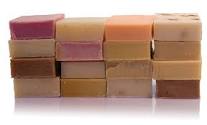All Soap is Not Created Equal:
The Health and Beauty Benefits of Natural Vs. Synthetic Soap
by www.SixWise.com
When you lather up with a bar or liquid soap, you’re counting
on that soap to remove dirt and germs from your body while gently cleansing your skin. You certainly wouldn’t expect
that very same soap to contain ingredients that could potentially cause far more damage than the germs you’re attempting
to remove … yet if you use many commercial soaps, that is precisely what you’re getting.
In fact, research
from the Environmental Working Group (EWG) found hat 57 percent of baby soaps -- certainly considered to be among
the most pure and gentle soap there is -- contains 1,4-dioxane, a probable human carcinogen that readily penetrates your skin!
How can this be? Because the U.S. government does not require safety testing on the ingredients in your personal care
products. As EWG explains:
“Cosmetics and other personal care products are an alarming example of government and
industry failures to protect public health. Federal health statutes do not require companies to test products or ingredients
for safety before they are sold. As a result, nearly all personal care products contain ingredients that have not been assessed
for safety by any accountable agency, and that are not required to meet standards of safety.”
Common Toxic
Ingredients in Synthetic Soap
Take a look at the soap and cleansers in your bathroom right now. If they contain
any of the following ingredients, you may want to think twice about using them (the following ingredients are also among the
top to AVOID when you’re looking for a new cleanser)
Fragrance: The chemicals in
fragrance have been linked to neurotoxicity, allergies/immunotoxicity, and other health concerns. In fact, an investigation into fragrances, perfumes and colognes by EWG found several areas of concern:
Triethanolamine: A fragrance ingredient and emulsifying agent that has been
linked to cancer, immune system toxicity, allergies, organ system toxicity, and potential endocrine disruption.
Triclosan: This is the active ingredient in many antibacterial soaps. This chemical belongs to the chlorophenol class of chemicals,
which are suspected of causing cancer in humans. According to the Environmental Protection Agency, triclosan is a pesticide
and was given high scores both as a human health risk and an environmental risk.
Parabens
and Phenols: Used in body wash and many other personal care products, according to the National Institutes of Health
phenol is toxic and people who are hypersensitive to it could experience death or serious side effects at very low exposures. Parabens have
also been linked to cancer and reproductive toxicity.
Phthalates: These industrial
compounds are widely used in hairsprays, perfumes and cosmetics. Animal studies on certain phthalates have shown the chemicals
may cause a variety of problems, including reproductive and developmental harm, organ damage, immune suppression, endocrine
disruption and cancer.
In order to avoid harmful chemicals, you need to read the product's label before
you buy. Avoid anything that has the chemicals listed above, including "paraben" (which may appear as methylparaben
or others) or "phthalate" (which can be listed as dibutyl and diethylhexyl or just "fragrance").
You
should know that the government does not regulate what "natural" means in soaps labeled natural, so commercial soaps
can freely claim to be natural while still using the synthetic compounds discussed above -- and they do.
So finding
safe and toxin-free soaps and body washes is not as simple as looking for the "all-natural," organic" or even
"hypoallergenic" label, as these products can still contain dangerous ingredients. The term "hypoallergenic"
can actually mean whatever a particular company wants it to mean, according to the FDA.
A general
rule of thumb - The fewer ingredients listed, the better. HawkMoon Soaps fit the bill, pure and simple.

